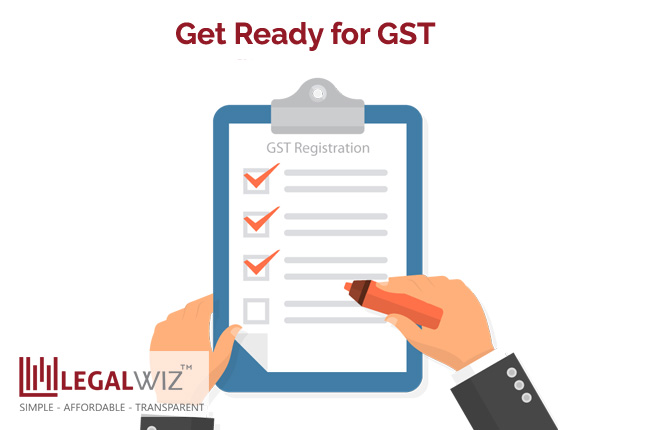GST Registration – Process, Rules, Forms and Documents Required
GST is an indirect tax which will replace all the current indirect taxes prevailing right now. It is rather a consolidated form of all the other taxes which will provide for single and streamline process. The GST is expected to ease the administration and enforcement for the government as well as the businesses. It is crucial to look upon the registration procedure for the GST.
Who are to be registered?
As per GST Law, any supplier who carries on any business at any place in India and whose aggregate turnover exceeds threshold limit as prescribed in a year is liable to get himself registered. It is also compulsory for the business to migrate to GST who is already registered under any tax regime. The Indian government has already declared the last date for the GST registration, which varies from state to state.
| Threshold limit for registration |
|
| Compulsory / Mandatorily registration irrespective of threshold limit |
|
| Place of registration |
|
| Threshold limit for payment of tax |
|
| For existing tax payers in earlier law |
|
| Validity of RC for casual taxable person / nonresident taxable person |
|
| Cancellation of Registration Certificate |
|
Registration Process
GST registration process will be online through a portal maintained by Central Government of India. Govt. will also appoint GSPs (GST Suvidha Providers) to help businesses with the registration process. All the existing tax payers under the Central Excise, CST, VAT and Service Tax paying Systems need not have to apply for the fresh registration of GSTIN (GST Identification No). They will have to file for a provisional ID which will be valid for 6 months as per the following procedure:
For converting your existing VAT/CST number into the GST Number:
- Login on your State VAT or CST or Service Tax Portal.
- Get the Provisional id and password of the same.
- Generate the new user id and password on the gst portal.
- Fill Up your business details with the promoter details & business address, bank details and upload the necessary documents.(encl. below)
- Verify with the digital signature or Aadhar Card EVC.
GST Registration Procedure:
- The applicant will need to submit his PAN, mobile number and email address in Part A of Form GST REG–01 on the GSTN portal.
- The PAN is verified on the GST Portal. Mobile number and E-mail address are verified with a one-time password (OTP). After the completion of verification, applicant will receive an application reference number on the registered mobile number and via E-mail. An acknowledgement should be issued to the applicant in FORM GST REG-02 electronically.
Download complete list of goods and service tax registration forms by clicking here. - Applicant needs to fill Part- B of Form GST REG-01 and specify the application reference number. Then the form can be submitted after attaching required documents.
- If additional information is required, Form GST REG-03 will be issued. Applicant needs to respond in Form GST REG-04 with required information within 7 working days from the date of receipt of Form GST REG-03.
- If you have provided all required information via Form GST REG-01 or Form GST REG-04, the registration certificate in Form GST REG –06 for the principal place of business as well as for every additional place of business will be issued to the applicant. If the person has multiple business verticals within a state he can file a separate application for the registration in Form GST REG-01 for each business verticals.
- If the details are not found to be reliable then the registration application will be rejected using Form GST REG-05. Form GST REG -07 is to be filled by the applicant who is required to deduct TDS or collect TCS. Further he can revoke the registration if he is no longer liable to deduct or collect tax at source then the officer may cancel and communicate the cancel of registration.
Required Documents for GST Registration
| Sr. No. | Business | Documents required |
| 1. | Sole Proprietorship Firm |
|
| 2. | Partnership Firm |
|
| 3. | Private Limited Company/ One Person Company |
|
| 4. | Limited Liability Partnership (LLP) |
|
After the registration further the applicant needs to file returns to maintain the registration.
| Return Frequency | Type Of Return | Form | Time Period | Late filing fee |
| Monthly Return | Outward Supplies | GSTR-1 | 10th of next month | Late Fee of Rs. 100 per day subject to maximum of Rs. 5000 |
| Inward Supplies | GSTR-2 | 15th of next month | ||
| Registered Taxable Person (Except Under Composition Scheme and Liable for TDS) | GSTR-3 | 20th of next month | ||
| Non Resident Taxable Person | GSTR-5 | 20th of next month | ||
| Input Service Distributer (ISD) | GSTR-6 | 13th of next month | ||
| Person Paying TDS | GSTR-7 | 10th of next month | ||
| Supplies affected through e-commerce operator | GSTR-8 | 10th of next month | – | |
| Quarterly Return | Person Paying tax under Composition Scheme | GSTR-4 | 18th of next month from the end of quarter | Late fee of Rs. 100 per day subject to maximum of Rs. 5000 |
| Annual Return | Registered Taxable Person (Except Under Composition Scheme, Liable for TDS), Casual Taxable Person and Non-Resident Taxable Person | GSTR-9 | 31st December from the end of financial year | Late fee of Rs. 100 per day subject to maximum 0.25% of aggregate turnover. |
| Final Return | Registered Taxable Person applying for cancellation | GSTR-10 | 3 months from the date of cancellation or order of cancellation order whichever is later. | Late fee of Rs. 100 per day subject to maximum of Rs. 5000. |
| Special agencies having Unique Identity Number (UIN) | Details of taxable supply of goods or services | GSTR-11 | At the time of filing of application for refund | – |

Shrijay Sheth
Shrijay, co-founder of LegalWiz.in, is best known for his business acumen. On this platform, he shares his experiences backed by a strong understanding of digital commerce businesses. His more than a decade-long career includes a contribution to some of the highly successful startups and eCommerce brands across the globe.
23 Comments
Leave A Comment








Thanks for information about GST process , rules and required document.
If you are going for finest contents like me, only
go to see this site all the time since it offers quality contents, thanks
I could not resist commenting. Exceptionally well written!
Hello there, just became aware of your blog through Google, and found
that it is really informative. I am going to watch out for brussels.
I’ll appreciate if you continue this in future. Lots of people will be benefited from your writing.
Cheers!
What’s up, yes this post is genuinely nice and I have learned lot of things from it on the topic of blogging.
thanks.
It’s amazing in favor of me to have a website, which is
valuable in favor of my knowledge. thanks admin
Saved as a favorite, I really like your web site!
I’ve been exploring for a little for any high quality articles or blog
posts in this sort of area . Exploring in Yahoo I at last
stumbled upon this website. Studying this information So i am satisfied to convey that I have a very excellent uncanny feeling I discovered exactly
what I needed. I such a lot unquestionably will make sure to do not put out of your mind this site and provides it a glance regularly.
These are truly fantastic ideas in concerning blogging.
You have touched some pleasant points here. Any way keep up wrinting.
Post writing is also a fun, if you know then you can write otherwise it is
difficult to write.
Why users still make use of to read news papers when in this
technological globe everything is existing on web?
Hi there friends, how is the whole thing, and what you would
like to say on the topic of this paragraph, in my view its truly awesome for me.
I seriously love your site.. Excellent colors & theme.
Did you make this web site yourself? Please reply back as I’m wanting to create my own personal blog and would like to know where you got this from or what the theme is called.
Appreciate it!
Oh my goodness! Awesome article dude! Thanks, However I am experiencing difficulties with your RSS.
I don’t understand the reason why I cannot subscribe to it.
Is there anybody else having the same RSS problems? Anyone who knows the solution can you kindly respond?
Thanks!!
Fantastic goods from you, man. I have understand your stuff previous
to and you are just too excellent. I actually like what you have acquired here, certainly like
what you’re saying and the way in which you say it. You make it enjoyable and you
still take care of to keep it wise. I can’t wait to read much more from you.
This is actually a great site.
It’s the best time to make some plans for the longer term and it is time
to be happy. I have read this put up and if I could
I want to suggest you some attention-grabbing issues or tips.
Maybe you could write subsequent articles referring to this article.
I desire to learn more things approximately it!
Really Useful information, and well-structured,
Youre so cool! I dont suppose Ive read anything like this before. So good to search out any individual with some unique ideas on this subject. realy thanks for beginning this up. this website is one thing that’s wanted on the web, someone with just a little originality. useful job for bringing something new to the web!
An impressive share, I just given this onto a colleague who was doing a little analysis on this. And he in reality purchased me breakfast as a result of I found it for him.. smile. So let me reword that: Thnx for the deal with! However yeah Thnkx for spending the time to debate this, I really feel strongly about it and love reading more on this topic. If possible, as you change into expertise, would you mind updating your weblog with more particulars? It’s highly helpful for me. Large thumb up for this blog submit!
You can certainly see your expertise within the work you write. The arena hopes for even more passionate writers such as you who are not afraid to mention how they believe. Always go after your heart.
It’s remarkable to pay a quick visit this web page and reading the views of all colleagues on the topic
of this paragraph, while I am also keen of getting know-how.
I just couldn’t go away your website prior to suggesting that I extremely enjoyed the standard information a person provide on your guests? Is going to be again often to check out new posts
I have read some good stuff here. Certainly worth bookmarking for revisiting. I wonder how much effort you put to make such a great informative site.